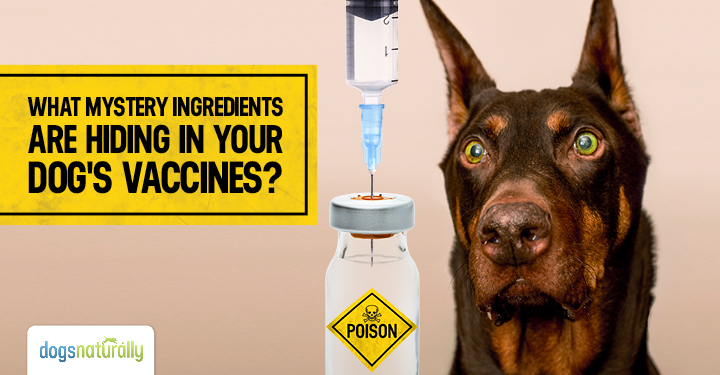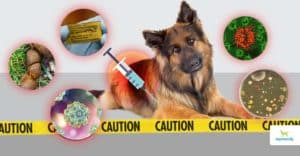If you’ve ever asked your conventional vet about the ingredients in dog vaccines, he probably told you they’re generally safe for your dog and that vaccine reactions are rare.
The fact is, your vet can’t say for sure what’s in your dog’s vaccines … because he doesn’t know.
Nobody does. Not even the US Food and Drug Administration (FDA), who’s responsible for allowing these drugs on the market.
That’s because the manufacturers hide behind descriptions like “trade secret” or “proprietary” when they report what’s in the vaccines. It’s shocking that the government agency responsible for drug safety lets companies get away with hiding their ingredients. But they do, as you can see from this extract from the Material Safety Data Sheet for the RabVac® 3 vaccine:

And here’s one for the Duramune® 5 Distemper, Adenovirus Type 2, Parainfluenza, (MLV) Parvovirus vaccine:
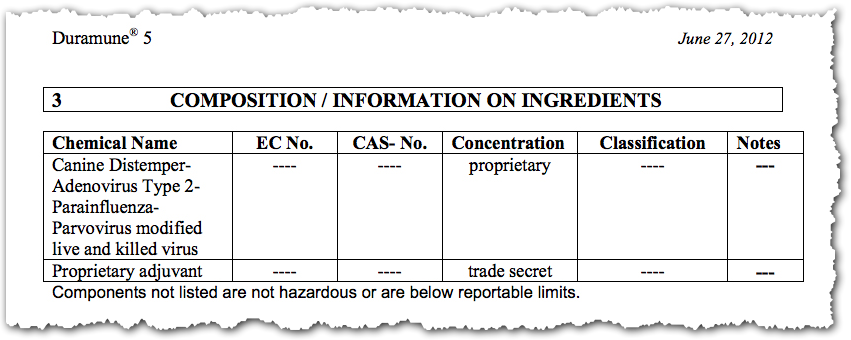
So when you vaccinate your dog, you have no way of knowing what harmful ingredients might be lurking under that “trade secret” or “proprietary” description.
Informed Consent
Before your vet gives your dog any drug or treatment for your dog, he has to tell you about the risks before you agree he can go ahead. That’s called informed consent, and you have a legal right to it as a client of the veterinary clinic.
But if your vet doesn’t know what’s in the vaccines and how toxic those ingredients might be, how can he comply with informed consent? Obviously, he can’t. So when he says vaccines are generally safe, you can’t really rely on that.
Vaccine Safety
If you ask a holistic vet whether vaccinations are safe – or effective – you’ll probably get a different story. She’ll likely tell you that vaccination or over-vaccination causes many chronic diseases that plague pets today. These reactions may not happen immediately, but weeks or even months after vaccination.
One of these vets is Patricia Jordan DVM. She’s spent decades researching and documenting vaccine risks, as well as the vaccine reactions she witnesses in her patients.
At the Natural Canine Health Symposium (NCHS) in 2015, she talked about some of the dangers lurking in pet vaccines.
Vaccines Are Not Tested
Dr Jordan says it’s a myth that vaccines have been thoroughly tested.
- There are no tests showing vaccines are “safe,” “necessary” or even “effective.
- There are no studies showing the gene impact of vaccines.
- There are no safety studies comparing vaccinated and unvaccinated populations.
Don’t assume vaccines to be safe just because your vet thinks they are. There’s no scientific basis for this belief.
How Vaccines Are Made
Vaccines include some part of the pathogen or disease agent. It stimulates the body to make antibodies to the disease the vaccine supposedly prevents.
To “power up” the reaction, the manufacturers add adjuvant chemicals and genetically engineered viruses. Vaccines don’t work without them! But these are very provocative agents that don’t belong in the body and can stimulate very harmful effects.
Other undesirable vaccine ingredients are things like heavy metals, light metals, toxic chemicals, cytotoxic agents (this means they kill cells), unknown viruses and protein sequences.
Protein sequences are “dragged over” from production of the vaccine. Viruses in vaccines are grown on living tissue, and they’re often from other species. That’s how monkey viruses like herpes 1 and 2, Epstein-Barr virus and others are passed on to humans through vaccination. Dogs are also exposed to retroviruses through their vaccines.
Only in the last few years have we begun to understand the dangers of ingredients like aluminum and mercury. We’ll talk more about those ingredients in a minute.
Vaccination Is Not Immunization
The purpose of the vaccination is to make antibodies to fight disease.
But the problem is that vaccination does not equal immunization. And the ingredients added to vaccines mistune the immune system and cause other damage.
Dr Jordan cites research by Dr J Compton Burnett, author of Vaccinosis And Its Cure By Thuja. It shows that if you are susceptible to disease but vaccinated for that disease, you’re more likely to catch it and die from it.
His mathematical model showed that vaccinations do NOT lower disease mortality and DO increase disease morbility – the frequency of the disease within the population.
That doesn’t sound like a desirable effect of vaccination, does it?
Toxic Ingredients
Early vaccines contained infectious material – meaning pus!
They were preserved in bird feathers for about three months. Starting in 1850, the manufacturers started using glycerol (glycerine) to try to preserve the vaccine and prevent decomposition. They’re still using it now.
But vaccine ingredients today are much more inflammatory and worrisome.
Nowadays vaccines include dangerous metals like mercury (thimerosal or ethylmercury) and aluminum. They also contain toxic ingredients like formaldehyde (a known carcinogen), and cytotoxic ingredients like phenol red.
- Thimerosal: vaccines still contain this ingredient despite the extreme neurotoxicity of mercury proven repeatedly in studies for decades. Some vaccines claim to be thimerosal free, but they may not be. Read more about this deceptive practice.
- Aluminum is a grade 3 (out of 4) carcinogen. It opens up the blood-brain barrier, allowing neurotoxins into the brain. It also up-regulates IgE, the allergy immunoglobulin, which makes your dog more susceptible to all kinds of allergies – skin issues, inhalant allergies, anaphylaxis and even death.
- And when vaccines contain both aluminum and mercury, the risks increase. Aluminum reduces the body’s ability to eliminate mercury, making the mercury even more toxic.
Vaccines also contain viruses and proteinaceous material that leads to autoimmune disease. An example of this is SV40, the monkey virus in polio vaccines that causes cancer.
In bacterial vaccines, the antigen causes the same immunopathology as the disease itself. This is especially true in Lyme and leptospirosis vaccines, which can cause conditions like renal failure and lead to death. It’s hard to swallow these effects when the diseases themselves aren’t lethal!
And there’s no independent research into the long-term or genetic effects of these ingredients.
Vaccine Reactions
First, let’s look at the “official” view from the American Veterinary Medical Association (AVMA) website. They advise pet owners to watch for the following mild reactions in the hours after vaccination:
- Discomfort and local swelling at the vaccination site
- Mild fever
- Decreased appetite and activity
- Sneezing, mild coughing, “snotty nose” or other respiratory signs two to five days after your pet receives an intranasal vaccine
The AVMA goes on to warn about “more serious, but less common side effects:”
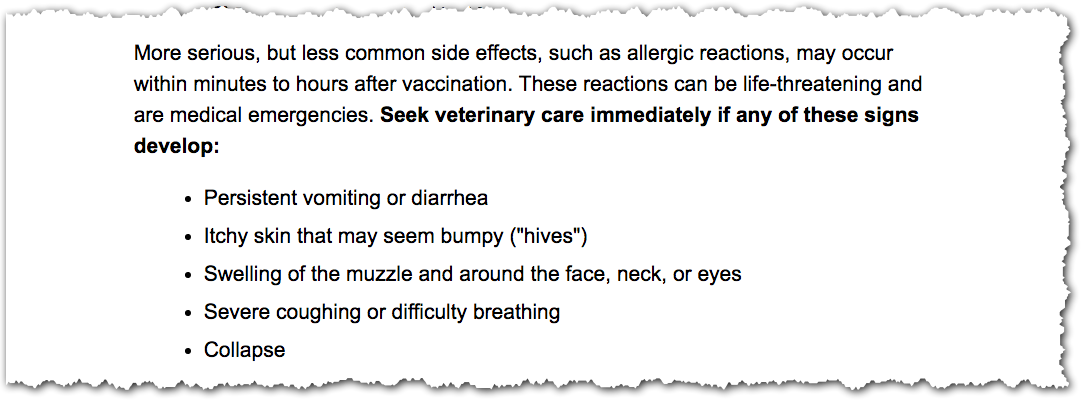
They also tell you that a “small, firm swelling under the skin may develop at the site of a recent vaccination”. If this doesn’t go away within two to three weeks, or seems to be getting larger, you should consult your veterinarian.
And they say that if your dog’s had a vaccine reaction in the past, you should tell your vet, and if in doubt, wait 30 to 60 minutes before taking your dog home.
But what they DON’T suggest is that you consider NOT giving the vaccination! Which would be a very smart decision if your dog’s already had a reaction in the past. It’s likely he’ll have one again, and it could be worse than the first one.
More Vaccinations, More Risk
When your vet vaccinates your dog over and over again, the risks of reactions increase dramatically.
- Immunologist H H Fudenberg stated:
“One vaccine decreases cell-mediated immunity by 50%, two vaccines by 70% ….”
Most dogs get many more than two vaccines, so you can imagine the cumulative effect on their immune systems of repeated vaccinations.
- A study by Dr Larry Glickman of Purdue University found that the risk of reactions increased by 27% for each additional vaccine given per office visit in dogs under 22 lbs, and by 12% in dogs over 22 lbs.
Every vaccination you give your dog increases the risk of a bad reaction, and just because he hasn’t had a reaction before, that doesn’t mean he won’t in the future.
There’s plenty of information available about the health risks to your dog. Many vets just don’t bother to learn more than they were taught in vet school.
The Real Risks Your Vet Should Know About
Leading veterinary immunologist Ronald D Schultz PhD lists common, moderate and severe potential reactions to vaccination.
Many of these reactions are not just acute reactions that occur right after vaccination, but chronic, ongoing conditions that can harm your dog’s health for life.
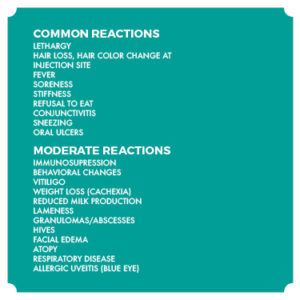
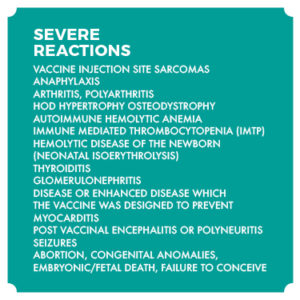
Dr Schultz acknowledges that vaccines against lethal viruses (rabies and distemper, possibly parvovirus) may be beneficial.
But his research shows that repeating vaccinations annually, or even every three years, is completely unnecessary to protect your dog from disease and that over-vaccination is harmful. Read this article to see how long vaccines protect your dog.
Dr Schultz also advises against using any bacterial vaccines (like leptospirosis, bordetella and Lyme). hHis research shows them to be ineffective.
Why Do Vets Continue To Over-Vaccinate?
Your dog’s vaccine can do lifelong harm. Dr Jordan says she and her fellow holistic veterinarians commiserate with each other that “everything we see is vaccinosis.”
And still, conventional vets don’t recognize vaccines as the real cause of many chronic diseases.
This is partly due to their training. Dr Schultz has said:
“Our new [vet school] grads don’t know a heck of a lot more about vaccines than our older grads. And I’ve figured out why this is. They know a lot more about basic immunology, but they don’t know about vaccinology and the two are not the same… So we haven’t gone very far from where we were ten years ago or twenty years ago with regard to training veterinarians about vaccines.”
In vet school, they don’t teach vets to consider vaccination as the reason for many chronic diseases. When you bring your pet in with something like a chronic skin condition, they call it allergies without understanding the connection to vaccination.
And because vets don’t make that connection, they don’t report the reactions to the drug companies. Very few vets report vaccine reactions – an estimated 1%. And even then, the report them to the drug companies, not to the FDA. What’s wrong with that picture? Shouldn’t the FDA know about the real side effects of these drugs?
And so the myth that vaccines are safe continues.
Big Business
Pet vaccination is big business and it’s growing. According to market research firm MarketsandMarkets, the global veterinary vaccines market could reach $7.2 billion by 2020. Thats’s up from $5.5 billion in 2015.
Dr Jordan calculates that about 15% of most clinics’ income is from vaccines … and another 65% comes from treating the resulting vaccine-induced diseases. When your dog develops chronic disease from vaccination, that’s a lifetime of income for the clinic. It’s easy to see why they want you to vaccinate.
Lack of training may be part of it. But is the financial incentive why many conventional vets don’t recognize the dangers of vaccination – or the vaccine reactions in your dog?

